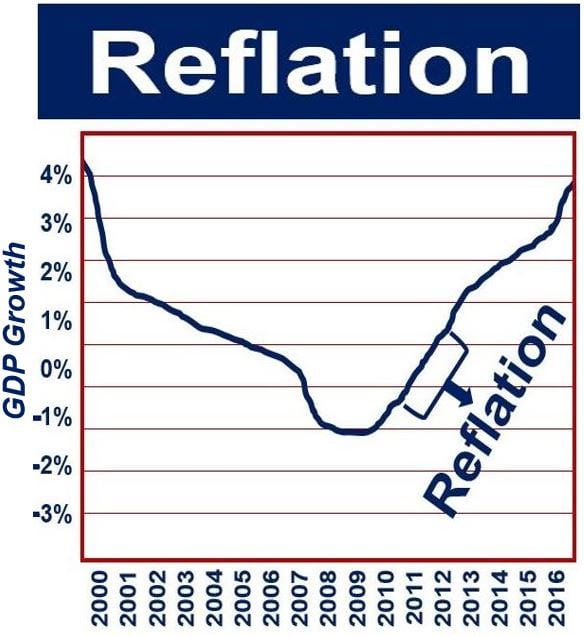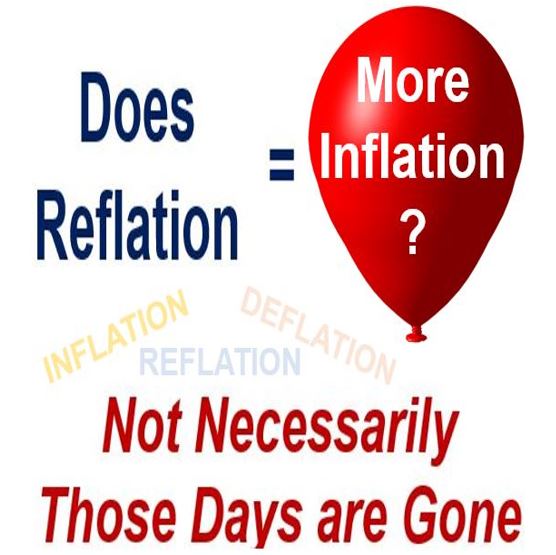Reflation is a monetary or fiscal policy by the government and central bank respectively to boost demand and thus increase the level of economic activity and combat deflation. Policies may include reducing interest rates, lowering taxes, investing in large infrastructure projects, and changing the money supply. Reflation may also refer to an economic phase after a period of recession – the initial stage of a nation’s economic recovery.
Reflationary policies are particularly critical during economic downturns, as they can stimulate spending and investment, thereby shortening the duration of a recession.
Monetary policy includes the things a country’s central bank does, such as influencing the money supply and raising or lowering interest rates. Fiscal policy includes the things the government does, such as altering levels of government spending and tax rates to influence aggregate demand in a country’s economy.
Reflation’s aim
The aim of reflation is to alter a deflationary trend. Deflation occurs when the prices of products and services decline – when the inflation rate is below zero; it is in negative figures. Do not confuse deflation with disinflation, which means inflation rising more slowly (a slowing down in the inflation rate).

The aim is to boost demand so that the economy expands again and inflation rises. The central banks of the US, Canada, EU, Japan and Australasia all have a 2% annual inflation rate target.
Nasdaq.com quotes Michael Gayed of Pension Partners, who said:
“Reflation is the process of restoring inflation to its long-run historical average, and can be considered a cure to potential deflation. [It is an attempt to] reduce the natural economic contraction – or reignite the business expansionary cycle – which invariably follows a significant expansion.”
“This can be done through monetary policy – central banks may increase the money supply, lower interest rates, and/or ease bank reserve requirement – or federal fiscal policy changes that lower taxes or loosen business regulations. All of these efforts are taken to increase the amount of money flowing through the economy and instill confidence in consumers and market players.”
Reflation – an example
Imagine a country’s inflation rate in 2016 is trending at 2% annually, and in 2017 deflationary pressures pull down that rate to zero percent.
Then in 2018, the nation’s central bank – such as the US Federal Reserve, the Bank of England, or the Bank of Japan – would introduce monetary policies to push the inflation rate back to its 2% long-term trend line.
As this 2% inflation target represents a return to the economy’s long-term trend, it is seen as reflation.
 The initial phase of an economic recovery, following a period of recession – when GDP starts growing again – is called the reflation period.
The initial phase of an economic recovery, following a period of recession – when GDP starts growing again – is called the reflation period.
In other words, reflation is a recovery of inflation when it has fallen below the long-term trend line.
Moreover, the success of reflation efforts can often be measured by the rate at which employment rises and the corresponding increase in consumer spending, signaling a return to economic stability.
The term ‘reflation’, with the meaning of boosting economic growth and restoring the long-term inflation line, was coined by Irving Fisher (1867-1947), an American economist, inventor, statistician, and progressive social campaigner – one of the first American neoclassical economists. Fisher introduced the term after the 1929 Wall Street Crash.
What is Trump’s reflation trade and how to define it?
Trump’s reflation trade is a term that emerged in the financial press in 2016. Economists predicted that if Donald Trump became the US President (which he did), we would likely see fiscal inflation that would drive growth with markets reflecting that.
During his inauguration speech, President Trump said:
“We are going to fix our inner cities and rebuild our highways, bridges, tunnels, airports, schools, hospitals. We’re going to rebuild our infrastructure, which will become, by the way, second to none. And we will put millions of our people to work as we rebuild it.”
 In an article in the Financial Times, Gavyn Davies wrote: “In mid 2016, the global economy embarked on a regime of reflation that has been dominating market behavior ever since then… The nature of the reflation theme is changing. The term ‘reflation’ does not necessarily imply that global inflation, or inflation expectations, will continue to rise very much from here.”
In an article in the Financial Times, Gavyn Davies wrote: “In mid 2016, the global economy embarked on a regime of reflation that has been dominating market behavior ever since then… The nature of the reflation theme is changing. The term ‘reflation’ does not necessarily imply that global inflation, or inflation expectations, will continue to rise very much from here.”
By singling out a public works infrastructure program, President Trump raised expectations in the bond market of a significant government stimulus that would raise debt levels, spur growth, and push up inflation. This would represent the end of a three-decade long period of yields at record low levels.
In an article in the Financial Times, Dan McCrum wrote:
“The so-called ‘inflation trade’ is a piece of verbal shorthand for the different ways prices will change if investors start to put money behind the view that growth and inflation will rise.”
Reflation trade refers to how the markets behave when inflation starts to rise after a long period of zero or very low inflation.
Reflation in other languages: relance (French), Revaloración (Spanish), Reflação (Portuguese), Reflation (German, Hindi, Indonesian, Swahili, Swedish), Reflazione (Italian), рефляция (Russian), リフレクション (Japanese), 重熔 (Chinese), الانعاش (Arabic), pemulihan semula (Malay), reflasjon (Norwegian), igangsætning af økonomisk opsving (Danish), elvytys (Finnish), heractivering van de economie (Dutch).
Abenomics: is a reflationary economic policy implemented by Japanese Prime Minister Shinzō Abe after winning the 2012 general election. For over two decades Japan has been stuck in a deflationary recession with virtually zero or negative GDP growth and zero or negative annual inflation rates.
Compound phrases with ‘deflation’
There are many compound phrases in the English language with the word ‘deflation.’ Here are five common ones:
-
Reflation Policy Measures
Specific actions taken by a government or central bank to stimulate economic growth.
For example: “The government announced new ‘reflation policy measures’ including tax cuts and increased public spending.”
-
Reflation Economic Cycle
The period during which economic activities are stimulated to recover from deflation.
For example: “Economists debate the optimal duration of a ‘reflation economic cycle’ before it overheats the economy.”
-
Reflation Fiscal Strategy
A government’s plan to use its budgetary tools to promote inflation and encourage economic growth.
For example: “The chancellor’s ‘reflation fiscal strategy’ focused on infrastructure spending to create jobs and increase demand.”
-
Reflation Expectation Adjustment
The revision of forecasts for economic recovery and inflation based on the effectiveness of reflation efforts.
For example: “Market analysts made a ‘reflation expectation adjustment’ in response to the central bank’s aggressive monetary easing.”
-
Reflation Trade Dynamics
Market trends associated with investments that benefit from economic recovery following a deflationary period.
For example: “Investors are closely monitoring ‘reflation trade dynamics’ to capitalize on the expected economic upswing.”
Video – What is Reflation?
This video, from our YouTube partner channel – Marketing Business Network, explains what ‘Reflation’ means using simple and easy-to-understand language and examples.
